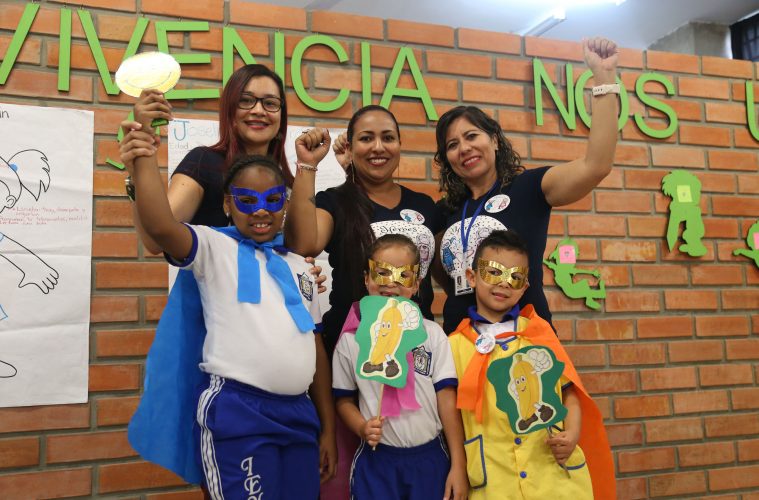The goal of “Heroes for Peace” is to redefine role models in the daily lives of school children in Medellín, Colombia. Three primary school teachers explain their efforts towards a more peaceful togetherness.
Heroes for Peace is a project within the capacity building program of the Innovation Lab for Education of Ruta N executed by a group of teachers at the Manuel Beltrán primary school in Medellín, Colombia. The school is located in East Manrique, a neighbourhood where the violation of rights and realities such as intra-family violence, parents abandoning their children, easy access to drugs and gang violence are common. We consequently experience many students with aggressive behaviour and low tolerance for their peers.
Heroes for Peace aims to transform the social references and role-models our students have by identifying members of their learning community who embody social values of leadership, solidarity, creativity, and rehabilitation.
We observed that the students are generally able to speak about peace and to understand the consequences of conflict, however when it comes to solving the day to day challenges they face, they do not address them by means of peaceful dialogue. Accordingly, we implemented a project to address this topic starting in primary school.
Development of the project
As of July 2016, half a year after the peace agreement between the government and the FARC guerilla was signed, and onwards, there have been various activities based on education methodologies that aim to improve the students’ interpersonal relations, promoting a healthy co-existence as a main part of the institution’s philosophy. The national peace process in Colombia seemed to be a great opportunity to make this topic more present through different projects, which is why we started the project “Heroes for Peace” in 2017.
Heroes for Peace aims to transform the social references and role-models our students have by identifying members of their learning community who embody social values of leadership, solidarity, creativity, and rehabilitation. Based on this, they deserve to be acknowledged and imitated as peace heroes of the community in order to create a territory of peace.
Pedagogical practices and learning dynamics such as sharing life stories, local history, geography and oral tradition have a significant impact on the success of the project. These promote wisdom and healthy co-existence and thereby integrate the students into the school environment in an enjoyable, positive and innovative way that fosters the development of their competencies and knowledge. The project activities are oriented towards exercises that create a sense of being, where the students start living a culture of peace based on respect.
Further strategies that generate an impact on the students include teaching them how to become mediators of conflicts inside and outside of the classroom. They acknowledge dialogue as a means to solve conflicts and to improve their community in search for peace. By transforming the social references of the children we create a peaceful territory inside of the school and strengthen the interpersonal bonds and the social fabric of our learning community.
Let’s talk about peace
In 2016, the peace agreement between Colombia’s President Juan Manuel Santos and the leader of the Revolutionary Armed Forces of Colombia (FARC) Rodrigo Londoño, alias “Timochenko” was signed. This event represented a challenge for all Colombians who now suddenly had the chance to dream about peace and a more just country. In this vein, we started different processes of sensibilization, reflection and transformation. On the one hand this involved teaching practices and on the other hand it was focused on interpersonal relations that invite the students to try other attitudes and forms of actions than the ones they know from their daily social realities. As a result, the school is evolving into a space where behaviour can be improved in order to contribute to peaceful co-existence.
We try to bring students, teachers, and parents closer to a culture of non-violence when solving conflicts by applying methods such as dialogue, mediation, non-aggression, reparation if possible, reconciliation and non-repetition. We understand peace as having respect for human dignity and care for the other. Additionally, it should allow the students to recognize their rights and obligations, and to start to take care of himself/herself, others and the environment. Based on the theoretical concepts of peace that have been brought to our institution by Professor Hilary Cremin from Cambridge University and Josefina Echavarría from the University of Innsbruck, we are now able to talk about ‘Peaces’ in plural, as they emerge from different visions and philosophical positions that have been constructed in relation to the understanding of peace and that are given different meanings in different societies.
The image of the Hero and Heroine
The type of hero and heroine we propose in our project is not a perfect and magical being with superpowers, but someone who is able to recognize her abilities and defects. A hero who is self-aware and knows, that despite her deficits, necessities, fears, defects and imperfections is capable of respecting herself. Based on resilience, this individual is able to design her life according to the principle of nonviolence and believes in the possibility to create a better world by helping others and spreading this attitude throughout her environment.
The type of hero and heroine we propose in our project is not a perfect and magical being with superpowers, but someone who is able to recognize her abilities and defects.
Our hero, is able to recognize diversity, the plurality among her fellows, families, teachers and friends. She is autonomous in her actions and achieves to live a life that affects many and leaves behind traces for others to follow. Our hero is imperfect, knows herself, and has the courage to live her history based on the principle of respect and human dignity. Our hero knows her soft powers, which some children would refer to as “knowing to listen to others and oneself”, “being able to care for and keep the environment clean”, and “take care of nature”. Moreover, our hero is able to express her feelings and emotions, is self-responsible in her actions, is able to help others in need and understands that each and everyone has a different form of thinking and being.
The project makes it possible to raise awareness and recognize the strength of many people of our neighbourhood who fight to move forward in their daily lives to create better circumstances, constantly saying no to the continuous violence that shapes their context. It is a pedagogical experience that has had a great impact on the local level as the students started recognizing themselves as subjects that know the rights that help creating a more peaceful environment, not only in school but also within their families and the community. “Heroes for Peace” is not only a school project, it is also an aim to sensitize people for positive conduct, a vision of community and the creation of active citizenship.
Authors:
Ana Carolina Vanegas Morales is Primary School Teacher at the Manuela Beltrán School with a basic education teachers license with an emphasis on social sciences. She is currently doing her Masters Degree in education at the University of Antioquia in Medellín. Contact: carito1990-07@hotmail.com
Lina Marcela Menses is Primary School teacher at the Manuela Beltrán School. Contact: linamame@gmail.com
Ana Yulieth Granados is Primary school teacher at the Manuela Beltrán School specialized in teaching and pedagogy, graduated from the University of the Andes Region. Licensed in basic education with emphasis on social sciences by the University of Antioquia. Contact: anyuliet17@hotmail.com
Diana Maria Arboleda is Preschool teacher specialized in environmental pedagogy with a degree from the University Popular del Cesar. Licensed in preschool education by the University of Antioquia. Contact: majavi10@hotmail.com

